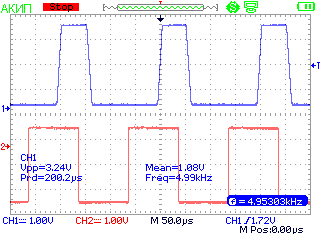Answer the question
In order to leave comments, you need to log in
Questions about RF433 Arduino modules?
Hello, I have a task to determine moving objects up to objects behind the walls.
I decided to use the Doppler effect. I know that there is a RCWL-0516 module, but I only have rf 433 modules at my disposal, I would also like to use them as a simultaneous method of transmitting information.
The questions themselves: is it possible to use the receiver from this set of modules as an sdr receiver?
Is it possible to change the received frequency or wavelength in it (programmatically)? "Similar to transmitter"
Didn't work with Arduino, so is it possible to connect both modules to the same MCU and alternately transmit and receive a signal with almost no delay (the picture below shows the delay between sending and receiving a signal)?
I found data from the oscilloscope on the receiving and transmitting legs of these modules.
(red - signal on the leg of the transmitter and blue - signal on the leg of the receiver).

Is it possible, by measuring the distance between the peaks of the receiver, to understand the Doppler effect that has occurred.
Can it be argued that the difference between the peak value of the sent and received signal will be the energy expended to overcome the signal through obstacles?
Is it possible to use them to transmit an analog signal?
PS Diagram of devices:

PPS I have never worked with electronics before, so if the questions seem silly, then I'm sorry.
Thank you in advance.
Answer the question
In order to leave comments, you need to log in
Dear mIka01 , tell the manager that until he himself figure out how to detect the Doppler shift from an object behind the wall using RF433 and 16MHz arduino, he doesn’t set such tasks for you in sales - except perhaps as a training project, the result of which is only training. RF433 uses amplitude modulation, the output signal shift is the result of, let's say, a triggered trigger that received a signal of sufficient length and level from the demodulator, which the device will consider as a unit and will be transmitted to the controller. From the Doppler shift, it depends very indirectly - in an incomprehensible direction, determined by the spread of the parameters of the elements. The shift will be greater with a bad signal. I'll draw

That meager Doppler effect, which will be created by those moving not by a steamboat and not by an airplane, will move the carrier in breadth or narrowness, and depending on the setting of the receiver's regenerator to this frequency, it will give a signal level higher or lower, and nothing more. The demodulator decision will be much more affected by multipath interference and interference - for you, this is noise and interference with the useful signal. I drew a diagram with guard intervals, but I'm not sure if the RF433 has them there, in my opinion it's just on / off, so you will suffer more from such noise. The signal at the output of the receiver will fidget in phase without transmitting in any way what is happening around the antennas. And for some kind of perversions with signal processing by the arduino itself, you will really miss the processor frequency, only 16 MHz,
If your boss tells you how to do it, don't torment, share! I'll even try it out.
Didn't find what you were looking for?
Ask your questionAsk a Question
731 491 924 answers to any question